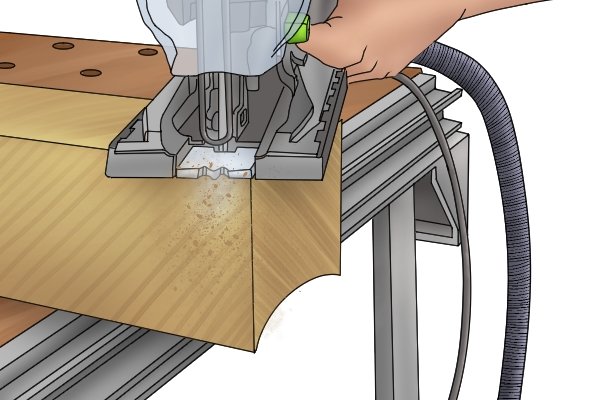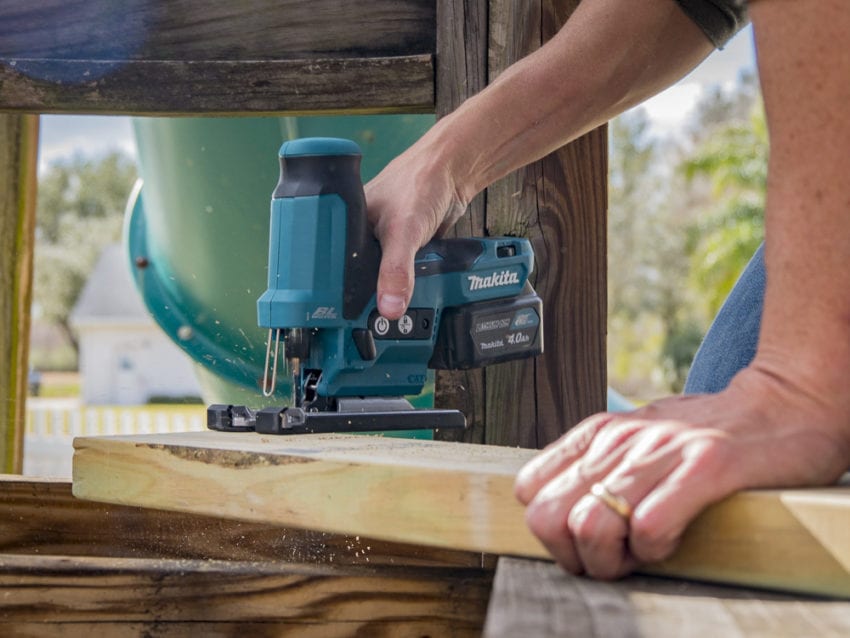Can a jigsaw cut thick wood? If you’ve ever wondered about this, you’re in the right place! Jigsaws are versatile power tools that are commonly used for cutting curves and intricate shapes in various materials. In this article, we’ll explore whether a jigsaw is up to the task of cutting through thick wood. So, let’s dive in and find out if a jigsaw can handle those hefty pieces of timber!
When it comes to cutting thick wood, a jigsaw can certainly be a useful tool to have. While it may not be the most powerful option out there, with the right blade and proper technique, it can still tackle thicker cuts. However, it’s important to note that there are limitations to what a jigsaw can handle. So, let’s uncover the factors that determine whether a jigsaw can effectively cut through thick wood.
Before we go any further, it’s crucial to understand that the success of cutting thick wood with a jigsaw depends on several factors. These include the type and quality of the jigsaw, the blade used, and the density of the wood. By taking these elements into consideration and implementing the right strategies, you can achieve clean and accurate cuts on thicker pieces of wood using a jigsaw. So, let’s explore the details and techniques to make this happen!
Yes, a jigsaw can cut thick wood with the right blade and technique. Follow these steps for successful cutting:
1. Choose the right blade for thick wood.
2. Securely clamp the wood to prevent vibrations.
3. Mark the cut line.
4. Start cutting slowly and steadily.
5. Use a slower speed setting for thicker wood.
6. Support the wood to prevent splintering.
With these steps, you can confidently use a jigsaw to cut thick wood.

Can a Jigsaw Cut Thick Wood?
The jigsaw is a versatile tool that is commonly used for various woodworking projects. However, when it comes to cutting thick wood, many DIY enthusiasts wonder if the jigsaw is up to the task. In this article, we will explore the capabilities of the jigsaw when it comes to cutting thick wood and provide you with practical tips to achieve clean and precise cuts. So, let’s delve into the world of the jigsaw and its abilities on thicker wooden materials.
Understanding the Jigsaw’s Cutting Capacity
When it comes to cutting thick wood, the capabilities of a jigsaw depend on a few key factors. Firstly, the power of the jigsaw will determine its ability to cut through thicker materials. Higher-powered jigsaws with more amps will have more torque and cutting power, enabling them to handle thicker wood with ease.
The second factor to consider is the jigsaw blade. The blade type and teeth per inch (TPI) will determine the smoothness and efficiency of the cut. For cutting thicker wood, it is essential to use a blade with fewer TPI and larger gullets. This allows for fast and efficient chip removal, preventing the blade from getting stuck while cutting through the material.
Additionally, using the right blade material is crucial. High-speed steel (HSS) blades are suitable for cutting softer woods and thin materials. However, for cutting thick wood, carbide-tipped blades are recommended. These blades are exceptionally durable and can withstand the rigors of cutting through dense materials without dulling quickly.
Benefits of Using a Jigsaw for Thick Wood
While some may doubt the ability of the jigsaw to cut through thick wood, it does come with several benefits that make it a viable option for these types of projects. One significant advantage is the jigsaw’s maneuverability. Its compact size and lightweight design allow for easy handling, giving you better control over the cutting process.
Moreover, the jigsaw’s orbital action adds to its cutting efficiency. The orbital action moves the blade forward and backward as it cuts, allowing for faster cutting progress. This feature is particularly useful when cutting through thicker materials, as it reduces the strain on both the tool and the user.
Another significant benefit of using a jigsaw for thick wood is the tool’s versatility. With the right blade and technique, a jigsaw can not only make straight cuts but also curved and beveled cuts. This versatility makes it suitable for a wide range of woodworking projects, regardless of the thickness of the wood.
Key Takeaways: Can a Jigsaw Cut Thick Wood?
- Yes, a jigsaw can cut thick wood, but it may have limitations.
- Choose the right blade for cutting thick wood, such as a coarse or aggressive blade.
- Slow down the cutting speed to prevent overheating the jigsaw or blade.
- Ensure you have a powerful jigsaw with enough motor strength for cutting thick wood.
- Practice good technique and use a guide or straight edge for more accurate cuts.
Frequently Asked Questions
In this section, we will address some common questions related to using a jigsaw to cut thick wood.
1. How thick of wood can a jigsaw cut?
A jigsaw can cut through various thicknesses of wood, depending on the capacity of the specific jigsaw you are using. While some jigsaws are designed for lighter tasks, others have the power and blade capacity to cut through thick wood. It is important to check the specifications of the jigsaw to ensure it is suitable for the thickness of wood you are working with. Generally, a standard jigsaw can handle wood up to 2-3 inches thick, while more heavy-duty models can cut through even thicker pieces.
Remember to consider the type of wood you are working with, as different types may require a more powerful jigsaw or a specific type of blade for efficient cutting. Always refer to the manufacturer’s recommendations for the maximum cutting capacity of your jigsaw.
2. Do I need a special blade to cut thick wood with a jigsaw?
To cut thick wood effectively with a jigsaw, it is recommended to use a specialized blade designed for such tasks. A general-purpose blade may struggle with thicker wood and result in slower cutting speed or an uneven finish. Thick wood requires a strong, robust blade with larger teeth and wider gullets to efficiently remove the material.
When selecting a blade, consider the thickness, hardness, and type of wood you are working with. Opt for a blade specifically designed for thick wood that offers aggressive cutting action and stability. Additionally, make sure the blade is compatible with your jigsaw model to ensure optimal performance.
3. Can a cordless jigsaw handle cutting thick wood?
Yes, cordless jigsaws can handle cutting thick wood, but it depends on the specific model, battery power, and the thickness of the wood. Cordless jigsaws have come a long way in terms of power and performance. High-capacity batteries and advanced motor technology have made it possible for some cordless models to cut through thick wood with ease.
When choosing a cordless jigsaw for cutting thick wood, look for a model with a high voltage battery and a powerful motor. It is also important to consider the cutting capacity of the jigsaw, as mentioned in its specifications. Keep in mind that while cordless jigsaws are convenient and portable, they may have slightly less power compared to corded models.
4. What safety precautions should I take when cutting thick wood with a jigsaw?
Cutting thick wood with a jigsaw requires proper safety precautions to prevent accidents or injuries. Here are some important safety measures to follow:
1. Eye and Ear Protection: Wear safety goggles to protect your eyes from flying debris and noise-canceling ear protection to prevent hearing damage.
2. Secure the Wood: Ensure the wood piece is firmly secured with clamps or a vice before cutting to prevent it from moving or vibrating during the cutting process.
3. Mark the Cut Line: Mark the precise cut line on the wood using a pencil or a marking tool to guide the jigsaw blade and ensure accurate cuts.
4. Proper Grip: Hold the jigsaw with a firm grip and maintain a stable stance throughout the cutting process to have better control and prevent slips or accidents.
5. Slow and Steady: Cut at a moderate speed, allowing the jigsaw blade to do the work. Avoid rushing or forcing the tool through the wood, as it can lead to kickback or blade breakage.
Always refer to the manufacturer’s instructions and guidelines for specific safety precautions related to your jigsaw model.
5. Are there any alternatives to a jigsaw for cutting thick wood?
Yes, there are alternative tools that can be used to cut thick wood if you don’t have access to a jigsaw or prefer a different cutting method. Some common alternatives include:
1. Circular Saw: A circular saw with a suitable blade can be used to cut thick wood. It offers straighter cuts and higher cutting capacity compared to a jigsaw.
2. Reciprocating Saw: A reciprocating saw, also known as a sawzall, is another option for cutting thick wood. It is ideal for rough cuts or when working in tight spaces.
3. Table Saw: If you have access to a table saw, it can be an excellent tool for cutting thick wood with precision and stability.
When using any of these alternative tools, it is important to take the necessary safety precautions and use the appropriate blades recommended for cutting thick wood.

What jigsaw blades to avoid drift when cutting thicker materials
Summary
Jigsaw can cut thick wood, but it works better on thinner and softer materials. Using the right blade and technique is important. Cutting thick wood may require multiple passes or a different tool. Jigsaws are great for curves and intricate designs. Safety precautions should be followed when using any power tool.
Overall, while jigsaws can cut thick wood, it’s best suited for smaller projects and softer materials. Remember to choose the right blade and practice proper safety measures to achieve the best results with your jigsaw.
